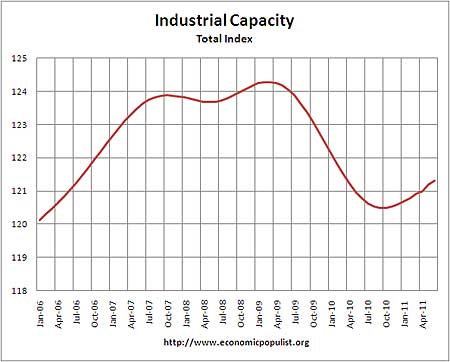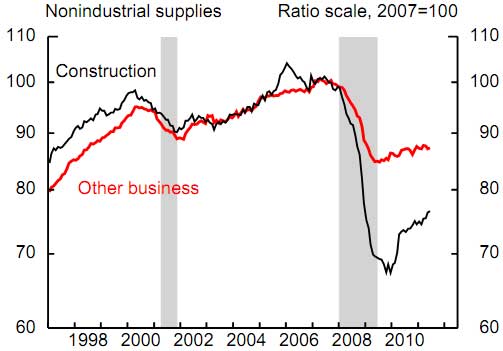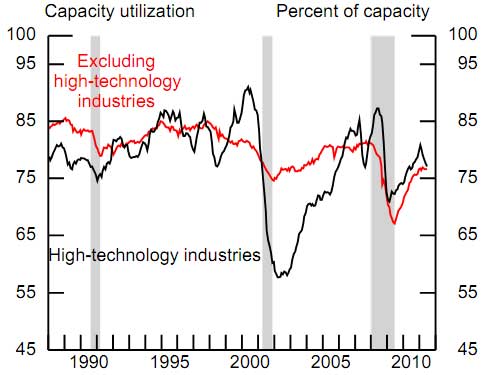The Federal Reserve's Factory Production report shows a measly 0.2% increase for June 2011 Industrial Production, otherwise known as output for factories and mines. May was revised downward to -0.1%. Manufacturing industrial production flat lined with no change and Japan supply disruptions are to blame according to the Fed. Autos & Parts did drop -2.0% in June, yet generally the market and industry group monthly changes were a mixed bag. Industrial production is still down -6.9% from pre-recession levels, in other words going on 4 years, even while up 3.4% from June 2010. Here is the Federal Reserve's detailed report.

Here are the major industry groups monthly industrial production percentage changes.
- Manufacturing: 0.0%
- Mining: +0.5%
- Utilities: +0.9%
Below is the graph of raw capacity, indexed against 2007 output. This is just how much capacity does the U.S. have to make stuff. Look at how total capacity has declined for the first time in the historical data. This index represents the raw facilities, potential to make stuff. Raw capacity is the underlying number by which utilization is calculated. This month capacity increased +0.2. We are on the increase, but still below pre-recession levels.

Below is the Fed's description of Market groups from the report and their monthly percent changes.
Production recorded a mix of gains and losses across the major market groups in June. Output for the second quarter as a whole moved up in most of the major market groups, although the production of consumer goods decreased at an annual rate of 1.2 percent. Declines in the output of consumer goods occurred for both durables and nondurables. In June, the production of consumer goods was unchanged, with a decline of 0.5 percent in durables offsetting an increase of 0.2 percent in nondurables. Among consumer durables, lower production of automotive products; appliances, furniture, and carpeting; and miscellaneous goods more than offset a small gain in home electronics. Within consumer nondurables, the output of non-energy nondurables was unchanged; increased output of chemical products was offset by declines elsewhere. The index for consumer energy products moved up 0.8 percent, with gains in the indexes for fuels and for residential utilities.
The production of business equipment declined 0.7 percent in June, with transit equipment and information processing equipment recording decreases of 1.9 percent and 1.4 percent, respectively, and industrial and other equipment being little changed. The output of business equipment increased at an annual rate of only 1.2 percent in the second quarter after gains averaging more than 12 percent over the previous five quarters. An increase of 7.0 percent in the production of transit equipment accounted for most of the rise in business equipment in the second quarter; the output of information processing equipment fell, and the output of industrial and other equipment was little changed.
In June, the index for defense and space equipment decreased 1.4 percent after having registered gains in each of the previous five months.
The output of construction supplies increased for the fourth consecutive month in June and climbed at an annual rate of 6.4 percent in the second quarter. The production of business supplies rose in June after having declined in both April and May and was little changed for the second quarter as a whole.
The output of materials to be further processed in the industrial sector increased 0.5 percent in June. The output of durable materials rose 0.7 percent. The indexes for all of its major categories advanced; the largest gain was an increase of 1.7 percent for consumer parts following two consecutive monthly declines. The index for nondurable materials edged down in June, while gains in both oil production and electricity generation helped boost the index for energy materials 0.8 percent. For the second quarter, materials output increased at an annual rate of 1.3 percent. The production of durable materials rose 1.1 percent, with gains in equipment parts and other durable materials more than offsetting a sizable decline in consumer parts. The output of nondurable materials moved down 3.9 percent; declines in chemical materials and paper materials more than offset a large increase for textile materials. The index for energy materials rose 5.2 percent.
Below is the industrial production graph for construction, in black, and we can see this entire sector has been decimated.

Below is another graph of industrial production since September 1990, indexed to that month. Look at the slope, the growth through the 1990's and then compare to 2000 decade. It was in 2000 when the China trade agreement kicked in and labor arbitrage of engineers, advanced R&D, I.T., STEM started in earnest.

Capacity utilization, or of raw capacity, how much is being used, for total industry is now 76.7%, which is unchanged from last month. But the Fed notes this is 3.7 percentage points below the average from 1972 to 2010, 80.4%. Capacity utilization has increased 2.2 percentage points from June 2010.
Below are capacity utilization's monthly percent change breakdown.
- manufacturing: 0.0%
- mining: +0.3%
- utilities: +0.7%
- selected high-technology industries: -0.6%
- crude: +0.2%
- primary: +0.4%
- finished: -0.4%
The below graphs show the overall decline of U.S. capacity utilization. Capacity utilization is how much can we make vs. how much are we currently using. These graphs show the U.S. is simply not producing what it is capable of, a reflection of the output gap. Note, this index is normalized to a specific year, currently from most reports, the 2007 yearly average (see year in the graph). Therefore, one cannot take absolute values of capacity utilization, i.e. 80%, and claim this is an indicator of a healthy economy, for it all depends on what year capacity utilization is normalized to. One can take the slope, or rate of change from the peak of a recession and determine recovery, but again, these percentages are relative, they are not absolute ratios to a static point in time. Also recall utilization is a percentage of real total capacity. Notice that total capacity in the United States has declined.
According to the report, manufacturing uses 77.8% of capacity, utilities 10.4% and mining 11.8%.

Below is the Manufacturing capacity utilization graph, normalized to 2007 raw capacity levels, going back to the 1990's. Too often the focus is on the monthly percent change, so it's important to compare capacity utilization to pre-recession levels and also when the economy was more humming.

One of the more interesting graphs is high tech capacity utilization, a special aggregate, shown below. It seems to correlate to when the high tech industry offshore outsourced in droves to China and notice the recent declines. Industrial production also shows declines in U.S. communications equipment manufacturing, which is -1.4 percentage points below it's February rate.

If you are baffled by what crude, finished mean, read these stages of production definitions.
The Federal Reserve releases detailed tables for more data, metrics not mentioned in this overview.
Last month's overview, not revised, is here.

Recent comments